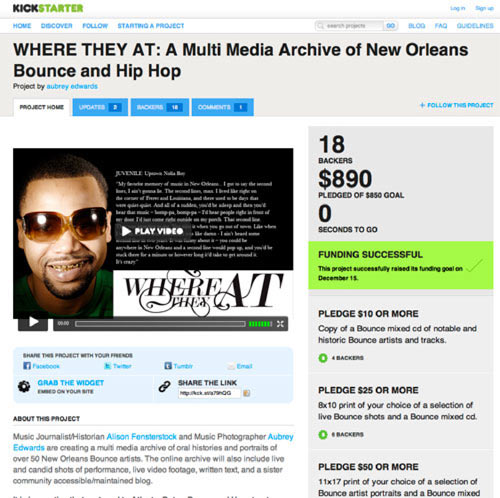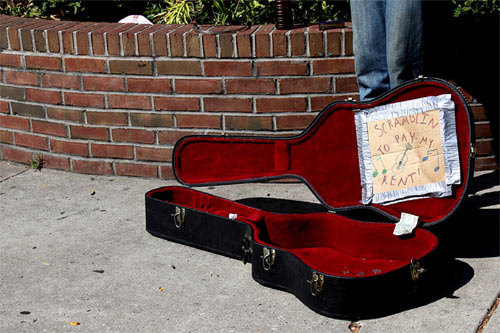We’re over a decade into the digital music revolution, and there’s a million ideas of how to compensate artists in a post-label world, but no sure bet. Big-name artists like Radiohead and Trent Reznor have successfully distributed albums directly to the people using pay-what-you-want schemes. Other artists with smaller-yet-passionate fan bases such as Kristin Hersh and Amanda Palmer (link possibly NSFW) have also enjoyed some success with a donation model. But as pleas for donations increasingly dominate my social network news feeds, I’m curious whether this new donation-driven creative economy is sustainable–particularly since the donor pool trends toward the creative professionals’ starving-artist peers.
 Photo By matthileo / Matt Katzenberger on Flickr
Photo By matthileo / Matt Katzenberger on Flickr
There’s a notion that the increased visibility social media offers, in conjunction with the Internet’s distributed tools of commerce, present a new business model to creative professionals. Since the music industry was one of the first creative businesses to be radically transformed by the Internet, much of this rhetoric is framed as a righteous battle between musicians, the industry and fans, with social media and online donations positioned as the liberators of the artists and their fans. The record industry, so the argument goes, was a middleman that became unnecessary as we entered the age of nearly-free digital distribution and social media promotions.
In practice, things haven’t proved quite so Utopian: maintaining an effective social media presence is a job in itself, often farmed out to interns by bands’ record labels or management companies, and the hyperactive mp3 blog hype cycle has become nearly as homogeneous and trend-oriented in its own way as the pop charts once were. Regardless, the artist-as-Internet-start-up myth persists. In his recent Poptimist column, Tom Ewing deconstructs this pervasive myth:
“Evangelists for a brave new post-record-biz world like to imagine musicians as start-ups: building a brand, leveraging social media, generally thinking outside the boombox. There's a Utopian element to all this– in the real world, musicians and business skills haven't traditionally mixed– and it's easy to read it as Silicon Valley's fantasy about itself as much as practical advice for an ailing industry: There's a reason entrepreneurs and gurus started calling themselves ‘rockstars.’ Meanwhile you can read a dozen articles about, say, Amanda Palmer's route to success and still come away with barely even a guess at what she actually sounds like.”
Despite the limitations of this model, there’s no argument that for a savvy, self-marketing musician, artist, writer or filmmaker, the shareable online world offers many opportunities. Online donation service Kickstarter may be the most successful implementation of this to date, offering a simple, attractively-designed service that allows creative professionals to solicit funding directly from their fan and friend communities. To some degree, Kickstarter builds upon the artist-as-start-up notion that Ewing skewers, but is far more grassroots and community-oriented than your typical start-up. Most Kickstarter projects are funded with small donations from friends, acquaintances and fans, not wealthy venture capitalists looking down from on high.
Kickstarter has had some notable successes in its short tenure: the service has helped fund an impressive number of creative projects. A few that come to mind include Where They At, a documentary film and online archive of queer New Orleans hip-hop, Coming & Crying, an anthology of stories about sex edited by Melissa Gira Grant and Meaghan O’Connell, and political cartoonist Ted Rall’s trip to Afghanistan for a hybrid comic/journalism project.

Yet there’s something about a donation-driven creative economy that services such as Kickstarter enable that makes me uneasy. I’ve considered using the service: I’ve got an album’s worth of material I’ve been sitting on for nearly five years, constantly delayed because of a lack of funds and (to be honest) a fair amount of procrastination. After recording multiple albums in the past on my home computer, I’ve been holding out until I can pay someone else to record the album. I’m not looking for a lavish studio, but I’d like a professional who costs more than $50 and a case of beer, who can record the vocals and the guitar and the drums on more than one pawn shop microphone. The resulting album will have, admittedly, niche appeal: I’m a 34-year-old freelance writer whose past musical successes have been modest and regional. Still, I’d like to have an album with a backing band, recorded by someone who knows what they’re doing, featuring album art from a professional artist who expects and deserves compensation, all pressed on a limited run of vinyl and sold digitally online for a modest sliding scale cost. These are pretty humble goals, but the require much more cash than I have on hand. A shareable solution to some of these costs exists: I can trade services with some of the vendors–write some copy for the artist, do some web consulting for the backing band members. But it’s harder to trade knowledge for a stack of physical product.
Yet this approach makes me uneasy. Is it insecurity? Fear that I won't be able to deliver? The dated and silly notion, inheirited from my English mother, that you "never ask for a handout"? Or is it my personal sense of Kickstarter fatigue?
A recent blog post by author Jami Attenberg speaks to that sense of fatigue. Attenberg urges young artists and creative producers to tap old-school funding sources before turning to their friends and fans, sources such as grant-giving organizations, their savings account, a trust fund, or family members. (Attenberg seems convinced that the artists soliciting Kickstarter donations all come from wealthy families, but judging from the creative professionals I personally know, this isn’t always the case.) She tartly addresses one of the fundamental problems that arises from Kickstarter overuse:
…please stop asking me. I know you’re ambitious, but for some reason your use of Kickstarter is starting to make me think you’re a little lazy.
Talking with friends and colleagues, I suspect that Attenberg and I are not alone in our Kickstarter fatigue, but for the time-being, it appears that we’re in the minority: a thoroughly unscientific, yet telling, glimpse on Amplicate (a service that aggregates online sentiment about various topics) puts Kickstarter “hate” at 3% and Kickstarter “love” at 97%. There’s no denying that the Kickstarter successes continue: Diaspora*, the open-source Facebook alternative we covered earlier raised over $200,000 using the service, and Adam Lisagor and Jesse Thorn’s “Put This On” web series about “dressing like a grown-up” has raised nearly $20,000 through a series of Kickstarter projects. In this tweet yesterday, Kickstarter announced that the service has raised $15 million dollars since its April 2009 launch, and that its amount of donations is increasing exponentially.
Put This On, Episode 2: Shoes from Put This On on Vimeo.
For the artists and fans that use Kickstarter, the service has earned quite an amount of trust, in no small part for its fail-safe method of ensuring pay-outs to the projects that meet their minimum donation goal. If you can’t achieve the necessary level of interest to reach your minimum solicited amount, the money pledged is returned to the donors. It’s a effectively Darwinian way of separating the wheat from the chaff, if somewhat unforgiving–I suspect that projects that appeal to an older, wealthier demographic such as Diaspora* or Put This On will prove more successful results than an activist punk band trying to raise money from cash-strapped teenage fans to embark on a basement tour across the nation.
Let me emphasize that I am not against the donation model in principle. It can be a fantastic way for creative professionals to interact directly with their fans and communities, which are much better creative partners than old-school distribution companies. I proudly donate to the user-supporter services I enjoy, whether they be public radio, Kickstarter projects such as Cellstories (which, full disclosure, has published my work), or podcasts such as WTF with Marc Maron, all funded primarily by fan contributions. I’m also a benefactor of donations: the literary culture blog I edit solicits reader donations, and your generous contributions to Shareable help compensate its contributors.
Still, I worry that we’re all going to the well too often. We’re soliciting donations for projects that don’t yet exist. Creative professionals may resemble Internet start-ups in superficial ways, but there are many fundamental differences. For one, venture capitalists invest with the hope of a major cash-out at the end. Most of us artists are in no position to offer our supporters potential profits in the future. Moreover, if our fans and communities do not grow exponentially, how many times will the same pool of people be willing to contribute to our projects? There are ways to reward those that support us–many artists both well-known and obscure have reaped large donations by offering perks and exclusive content to large donors. The Musician’s Guide to Fan Funding details some of the ways that artists have successfully crowdsourced their income, and this post at Flagpole goes deeper into some of the considerations artists should make when planning a donation-funder programs.
When we reach out to our communities to fund our creative and artistic projects, we have to acknowledge that we’re making a tenuous social contract, and that we must reward the goodwill and generosity of our communities and fan bases. And ultimately, no matter how much breathless hype new media gurus propagate (often via lucrative book deals from old-school media corporations), donations can’t be the only way we fund the creative arts: there’s a finite number of potential donors, and in the midst of recession, an ever-shrinking pool of money available to give. Contributions can be an important component in monetizing creative content, but there’s not enough goodwill, or money, for them to be our sole source of income. There are plenty of other effective alternatives, from live appearances to merchandising to the old-fashioned transaction of goods (physical or digital) for cash. Donation services should certainly play a role, but cannot fund our creative projects alone.









